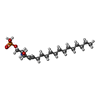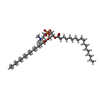+ Open data
Open data
- Basic information
Basic information
| Entry | Database: PDB / ID: 7lhv | |||||||||||||||||||||||||||||||||||||||
|---|---|---|---|---|---|---|---|---|---|---|---|---|---|---|---|---|---|---|---|---|---|---|---|---|---|---|---|---|---|---|---|---|---|---|---|---|---|---|---|---|
| Title | Structure of Arabidopsis thaliana sulfate transporter AtSULTR4;1 | |||||||||||||||||||||||||||||||||||||||
 Components Components | Sulfate transporter 4.1, chloroplastic | |||||||||||||||||||||||||||||||||||||||
 Keywords Keywords | TRANSPORT PROTEIN / Sulfate transport / SLC26 / MEMBRANE PROTEIN | |||||||||||||||||||||||||||||||||||||||
| Function / homology |  Function and homology information Function and homology informationchloroplast membrane / secondary active sulfate transmembrane transporter activity / symporter activity Similarity search - Function | |||||||||||||||||||||||||||||||||||||||
| Biological species |  | |||||||||||||||||||||||||||||||||||||||
| Method | ELECTRON MICROSCOPY / single particle reconstruction / cryo EM / Resolution: 2.75 Å | |||||||||||||||||||||||||||||||||||||||
 Authors Authors | Wang, L. / Chen, K. / Zhou, M. | |||||||||||||||||||||||||||||||||||||||
| Funding support |  United States, 2items United States, 2items
| |||||||||||||||||||||||||||||||||||||||
 Citation Citation |  Journal: Nat Commun / Year: 2021 Journal: Nat Commun / Year: 2021Title: Structure and function of an Arabidopsis thaliana sulfate transporter. Authors: Lie Wang / Kehan Chen / Ming Zhou /  Abstract: Plant sulfate transporters (SULTR) mediate absorption and distribution of sulfate (SO) and are essential for plant growth; however, our understanding of their structures and functions remains ...Plant sulfate transporters (SULTR) mediate absorption and distribution of sulfate (SO) and are essential for plant growth; however, our understanding of their structures and functions remains inadequate. Here we present the structure of a SULTR from Arabidopsis thaliana, AtSULTR4;1, in complex with SO at an overall resolution of 2.8 Å. AtSULTR4;1 forms a homodimer and has a structural fold typical of the SLC26 family of anion transporters. The bound SO is coordinated by side-chain hydroxyls and backbone amides, and further stabilized electrostatically by the conserved Arg393 and two helix dipoles. Proton and SO are co-transported by AtSULTR4;1 and a proton gradient significantly enhances SO transport. Glu347, which is ~7 Å from the bound SO, is required for H-driven transport. The cytosolic STAS domain interacts with transmembrane domains, and deletion of the STAS domain or mutations to the interface compromises dimer formation and reduces SO transport, suggesting a regulatory function of the STAS domain. | |||||||||||||||||||||||||||||||||||||||
| History |
|
- Structure visualization
Structure visualization
| Movie |
 Movie viewer Movie viewer |
|---|---|
| Structure viewer | Molecule:  Molmil Molmil Jmol/JSmol Jmol/JSmol |
- Downloads & links
Downloads & links
- Download
Download
| PDBx/mmCIF format |  7lhv.cif.gz 7lhv.cif.gz | 212.1 KB | Display |  PDBx/mmCIF format PDBx/mmCIF format |
|---|---|---|---|---|
| PDB format |  pdb7lhv.ent.gz pdb7lhv.ent.gz | 166.4 KB | Display |  PDB format PDB format |
| PDBx/mmJSON format |  7lhv.json.gz 7lhv.json.gz | Tree view |  PDBx/mmJSON format PDBx/mmJSON format | |
| Others |  Other downloads Other downloads |
-Validation report
| Summary document |  7lhv_validation.pdf.gz 7lhv_validation.pdf.gz | 1.3 MB | Display |  wwPDB validaton report wwPDB validaton report |
|---|---|---|---|---|
| Full document |  7lhv_full_validation.pdf.gz 7lhv_full_validation.pdf.gz | 1.3 MB | Display | |
| Data in XML |  7lhv_validation.xml.gz 7lhv_validation.xml.gz | 44.1 KB | Display | |
| Data in CIF |  7lhv_validation.cif.gz 7lhv_validation.cif.gz | 64.6 KB | Display | |
| Arichive directory |  https://data.pdbj.org/pub/pdb/validation_reports/lh/7lhv https://data.pdbj.org/pub/pdb/validation_reports/lh/7lhv ftp://data.pdbj.org/pub/pdb/validation_reports/lh/7lhv ftp://data.pdbj.org/pub/pdb/validation_reports/lh/7lhv | HTTPS FTP |
-Related structure data
| Related structure data |  23351MC M: map data used to model this data C: citing same article ( |
|---|---|
| Similar structure data |
- Links
Links
- Assembly
Assembly
| Deposited unit | 
|
|---|---|
| 1 |
|
- Components
Components
| #1: Protein | Mass: 75168.164 Da / Num. of mol.: 2 Source method: isolated from a genetically manipulated source Source: (gene. exp.)   Trichoplusia ni (cabbage looper) / References: UniProt: Q9FY46 Trichoplusia ni (cabbage looper) / References: UniProt: Q9FY46#2: Chemical | ChemComp-S1P / ( #3: Chemical | #4: Chemical | #5: Water | ChemComp-HOH / | Has ligand of interest | Y | Has protein modification | N | |
|---|
-Experimental details
-Experiment
| Experiment | Method: ELECTRON MICROSCOPY |
|---|---|
| EM experiment | Aggregation state: PARTICLE / 3D reconstruction method: single particle reconstruction |
- Sample preparation
Sample preparation
| Component | Name: Sulfate transporter 4;1 / Type: COMPLEX / Entity ID: #1 / Source: RECOMBINANT |
|---|---|
| Molecular weight | Value: 0.070 MDa / Experimental value: NO |
| Source (natural) | Organism:  |
| Source (recombinant) | Organism:  Trichoplusia ni (cabbage looper) Trichoplusia ni (cabbage looper) |
| Buffer solution | pH: 6 |
| Specimen | Embedding applied: NO / Shadowing applied: NO / Staining applied: NO / Vitrification applied: YES |
| Vitrification | Cryogen name: ETHANE |
- Electron microscopy imaging
Electron microscopy imaging
| Experimental equipment |  Model: Titan Krios / Image courtesy: FEI Company |
|---|---|
| Microscopy | Model: FEI TITAN KRIOS |
| Electron gun | Electron source:  FIELD EMISSION GUN / Accelerating voltage: 300 kV / Illumination mode: SPOT SCAN FIELD EMISSION GUN / Accelerating voltage: 300 kV / Illumination mode: SPOT SCAN |
| Electron lens | Mode: BRIGHT FIELD |
| Image recording | Electron dose: 50 e/Å2 / Film or detector model: GATAN K3 (6k x 4k) |
- Processing
Processing
| Software | Name: PHENIX / Version: 1.19.1_4122: / Classification: refinement | ||||||||||||||||||||||||
|---|---|---|---|---|---|---|---|---|---|---|---|---|---|---|---|---|---|---|---|---|---|---|---|---|---|
| EM software | Name: PHENIX / Category: model refinement | ||||||||||||||||||||||||
| CTF correction | Type: NONE | ||||||||||||||||||||||||
| Symmetry | Point symmetry: C2 (2 fold cyclic) | ||||||||||||||||||||||||
| 3D reconstruction | Resolution: 2.75 Å / Resolution method: FSC 0.143 CUT-OFF / Num. of particles: 838096 / Symmetry type: POINT | ||||||||||||||||||||||||
| Refine LS restraints |
|
 Movie
Movie Controller
Controller



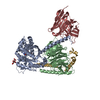

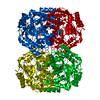

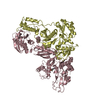
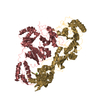
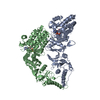
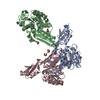
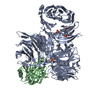
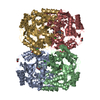
 PDBj
PDBj
